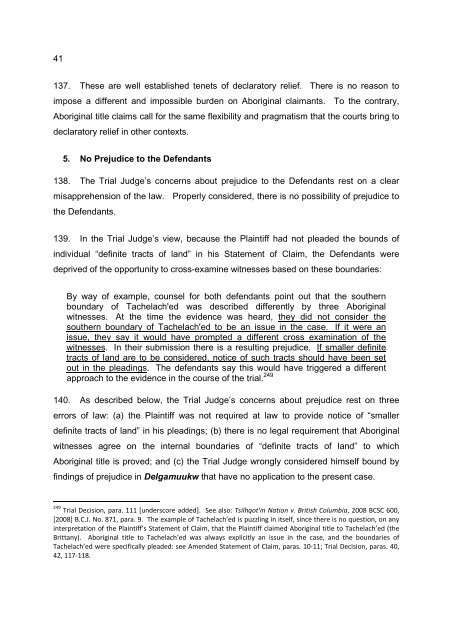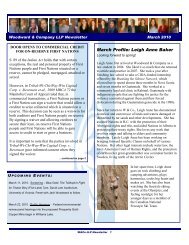Appellants factum - Woodward & Company
Appellants factum - Woodward & Company
Appellants factum - Woodward & Company
You also want an ePaper? Increase the reach of your titles
YUMPU automatically turns print PDFs into web optimized ePapers that Google loves.
41137. These are well established tenets of declaratory relief. There is no reason toimpose a different and impossible burden on Aboriginal claimants. To the contrary,Aboriginal title claims call for the same flexibility and pragmatism that the courts bring todeclaratory relief in other contexts.5. No Prejudice to the Defendants138. The Trial Judge’s concerns about prejudice to the Defendants rest on a clearmisapprehension of the law. Properly considered, there is no possibility of prejudice tothe Defendants.139. In the Trial Judge’s view, because the Plaintiff had not pleaded the bounds ofindividual “definite tracts of land” in his Statement of Claim, the Defendants weredeprived of the opportunity to cross-examine witnesses based on these boundaries:By way of example, counsel for both defendants point out that the southernboundary of Tachelach'ed was described differently by three Aboriginalwitnesses. At the time the evidence was heard, they did not consider thesouthern boundary of Tachelach'ed to be an issue in the case. If it were anissue, they say it would have prompted a different cross examination of thewitnesses. In their submission there is a resulting prejudice. If smaller definitetracts of land are to be considered, notice of such tracts should have been setout in the pleadings. The defendants say this would have triggered a differentapproach to the evidence in the course of the trial. 249140. As described below, the Trial Judge’s concerns about prejudice rest on threeerrors of law: (a) the Plaintiff was not required at law to provide notice of “smallerdefinite tracts of land” in his pleadings; (b) there is no legal requirement that Aboriginalwitnesses agree on the internal boundaries of “definite tracts of land” to whichAboriginal title is proved; and (c) the Trial Judge wrongly considered himself bound byfindings of prejudice in Delgamuukw that have no application to the present case.249 Trial Decision, para. 111 [underscore added]. See also: Tsilhqot'in Nation v. British Columbia, 2008 BCSC 600,[2008] B.C.J. No. 871, para. 9. The example of Tachelach’ed is puzzling in itself, since there is no question, on anyinterpretation of the Plaintiff’s Statement of Claim, that the Plaintiff claimed Aboriginal title to Tachelach’ed (theBrittany). Aboriginal title to Tachelach’ed was always explicitly an issue in the case, and the boundaries ofTachelach’ed were specifically pleaded: see Amended Statement of Claim, paras. 10-11; Trial Decision, paras. 40,42, 117-118.



